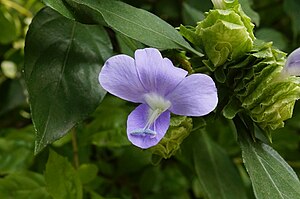Note: This is a project under development. The articles on this wiki are just being initiated and broadly incomplete. You can Help creating new pages.
Difference between revisions of "Barleria strigosa - Nīlajhiṇṭī"
(→Identification) |
(→References) |
||
| Line 69: | Line 69: | ||
<ref name="chemical composition">[http://gbpihedenvis.nic.in/PDFs/Glossary_Medicinal_Plants_Springer.pdf Chemical composition]</ref> | <ref name="chemical composition">[http://gbpihedenvis.nic.in/PDFs/Glossary_Medicinal_Plants_Springer.pdf Chemical composition]</ref> | ||
<ref name="Leaf">[ "Morphology"]</ref> | <ref name="Leaf">[ "Morphology"]</ref> | ||
| − | <ref name="How to plant/cultivate">[ "Cultivation detail"]</ref> | + | <ref name="How to plant/cultivate">[https://indiabiodiversity.org/species/show/250255"Cultivation detail"]</ref> |
</references> | </references> | ||
Revision as of 10:33, 24 June 2019
Nīlajhiṇṭī consists of root of Barleria strigosa Willd. (Fam. Acanthaceae), a tall herb which is distributed throughout the upper gangentic plain and southern parts of India.
Contents
- 1 Uses
- 2 Parts Used
- 3 Chemical Composition
- 4 Common names
- 5 Properties
- 6 Habit
- 7 Identification
- 8 List of Ayurvedic medicine in which the herb is used
- 9 Where to get the saplings
- 10 Mode of Propagation
- 11 How to plant/cultivate
- 12 Commonly seen growing in areas
- 13 Photo Gallery
- 14 References
- 15 External Links
Uses
Serious catarrhal infections, Boils, Snake bites, Sores.
Parts Used
[[:Category:Herbs with used in medicine|]], [[:Category:Herbs with used in medicine|]], [[:Category:Herbs with used in medicine|]], [[:Category:Herbs with used in medicine|]].
Chemical Composition
The plant gave beta-and gammasitosterol. [1]
Common names
| Language | Common name |
|---|---|
| Kannada | |
| Hindi | |
| Malayalam | |
| Tamil | |
| Telugu | |
| Marathi | NA |
| Gujarathi | NA |
| Punjabi | NA |
| Kashmiri | NA |
| Sanskrit | |
| English |
Properties
Reference: Dravya - Substance, Rasa - Taste, Guna - Qualities, Veerya - Potency, Vipaka - Post-digesion effect, Karma - Pharmacological activity, Prabhava - Therepeutics.
Dravya
Rasa
Guna
Veerya
Vipaka
Karma
Prabhava
Habit
Identification
Leaf
| Kind | Shape | Feature |
|---|---|---|
| Simple | Opposite | Petiole brownish yellowish strigose and 0.7–2.5cm. Leaf blade is ovate to elliptic, both surfaces are fulvous strigose along veins, 5.5–15x2.2–5.5 cm, secondary veins are ~7 on each side of the midvein, base is cuneate and decurrent on to the petiole and apex is acute. |
Flower
| Type | Size | Color and composition | Stamen | More information |
|---|---|---|---|---|
| Bisexual | Terminal spikes | pink-violet | Flowers in terminal dense spikes and in axillary to 5 cm. Bracts are elliptic-oblong to oblong, abaxially along veins strigose, apex is sharply acute. Bracteoles are elliptic and ~1.2cm, single-veined, apex is acute and margin ciliate. Outer calyx ovate, lobes are purple, ~3.2 x 1.8 cm, base is rounded, margin dentate to subentire, apex is acute, inner calyx is yellowish brown, lanceolate, both the surfaces are strigose, ~1.5x0.2 cm. Outer lobes of calyx purple, ~3.2 x 1.8 cm, margin subentire to dentate, base rounded, apex is acute. Inner calyx is lanceolate, yellowish brown, ~1.5 x 0.2 cm, apex is acute and both surfaces are strigose. The corolla is 5-6 cm, purplish red, tube is basally cylindric for ~3.7cm, throat is ~1.2cm, lobes are obovate-oblong. |
Fruit
| Type | Size | Mass | Appearance | Seeds | More information |
|---|---|---|---|---|---|
| Capsule | 1.4–1.8 x ca. 0.5 cm | Capsule is ellipsoid, glabrous, 1.4–1.8 x ca. 0.5 cm, shining, four-seeded. |
Other features
List of Ayurvedic medicine in which the herb is used
Where to get the saplings
Mode of Propagation
How to plant/cultivate
Commonly seen growing in areas
[[:Category:Herbs that are commonly seen in the region of |]], [[:Category:Herbs that are commonly seen in the region of |]].
Photo Gallery
References
- ↑ Chemical composition
- ↑ [ "Morphology"]
- ↑ "Cultivation detail"
External Links
- Ayurvedic Herbs known to be helpful to treat Serious catarrhal infections
- Ayurvedic Herbs known to be helpful to treat Boils
- Ayurvedic Herbs known to be helpful to treat Snake bites
- Ayurvedic Herbs known to be helpful to treat Sores
- Herbs with used in medicine
- Habit - Evergreen shrub
- Index of Plants which can be propagated by Seeds
- Herbs that are commonly seen in the region of
- Herbs
- Acanthaceae



